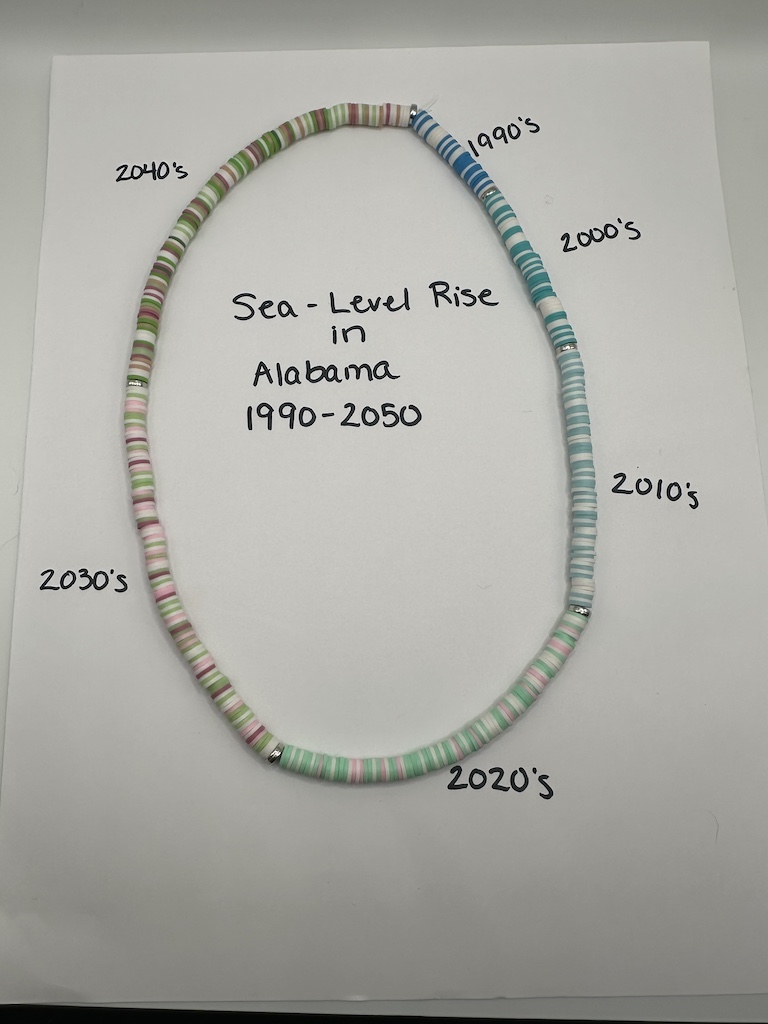News | March 4, 2025
Introducing the Latest Sea Level Teaching Tool: Friendship Bracelets

Sea level bracelets use different colors and sizes to represent time frames and locations. Image credit: Ali Rellinger
The question: How can NASA data be used to teach young people about sea level change?
The answer: Making NASA data on rising sea level more accessible includes bringing it to vulnerable communities.
For Ali Rellinger, an extension instructor at Mississippi State University and the head of the climate adaptation extension program at the Mississippi-Alabama Sea Grant, the place to start was among students.
“We’re trying to come up with ways to have younger folks engage with that data and just really understand,” Rellinger said. “People don’t understand that a significant amount of sea level rise has already occurred, and that we’re expecting it to accelerate more in the future.”
Rellinger was considering how best to reach young learners when she saw the scattered beads in her house used to make friendship bracelets during Taylor Swift’s “Eras” Tour. That’s when the idea struck: “measuring” the rise in sea level using beads on a bracelet.
Each bracelet could represent a certain time frame, and different colored beads could be stacked together to show sea level rise across decades.
“[It’s] a lot more fun for kids and adults than asking them to make a graph in their classroom or their summer camp,” Rellinger said. “I thought that would be a great way to remind people, when we say an inch [of sea level rise], we can compare the past and the present side-by-side in a way that just made sense.”

Rellinger would turn this into an activity as part of the NASA Science Activation program. For the data needed to craft the bracelets, Rellinger draws on NASA’s recently released National Sea Level Explorer – an online tool that lets users customize accessible graphs and visuals to represent sea level change for specific times and places along U.S. coastlines. Rellinger’s student project does much the same.
“I’m picking the data that’s really relevant to us, but you could also do the entire United States, you could do the East Coast averages,” she said. “Each learner can do something really local to where they are, but then they could also compare. They could make themselves a Gulf of Mexico bracelet and one for the U.S. as a whole, and see that side-by-side, the Gulf is a lot more than the average for the U.S.”
Why it’s important: Rellinger’s project has already reached classrooms and homeschooling groups across coastal Mississippi, Alabama, and Florida. Next summer, she hopes to host even more bracelet-building sessions in other communities.
“We have a ton of summer camps planned, and so then we’ll be doing this with all our different groups,” she said. “We’ve gotten to do it with a few [classrooms] during the school year, but in the summer, we will be out making sea level rise bracelets in full force with kids in our [coastal] community.”
The main reason for her initiative, Rellinger said, is to make the next generation better aware of rising sea levels.
“Living in a coastal community, we know that this impacts so many parts of our everyday life, our natural and community resources,” she said. “So getting students to understand that it is happening and it will happen in the future is the first step to getting them to have solutions. Now we can see what is happening is tangible and that we don’t want to dismiss it.”
